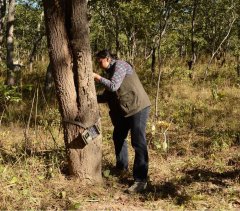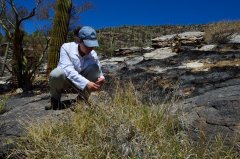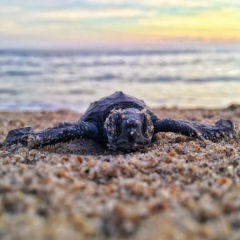News & Announcements
Digital Life on Earth
UMass Amherst’s Digital Life Project creates visual records of critically endangered species
Digital Life on Earth
UMass Amherst’s Digital Life Project creates visual records of critically endangered species
The Digital Life Project at the University of Massachusetts Amherst has been revolutionary in creating visual records of critically endangered species in ways that technology has never allowed before.
The project team modeled the first-ever 3D image of a southern right whale after researchers used aerial photography and drone videos to measure the mass and volume of whales. Previously, the only way to weigh any whale was by using a dead or stranded animal. Using its innovative Beastcam array, the team has also produced the world’s first accurate 3D image of the southern white rhino.
Led by Professor of Biology Duncan Irschick, the Digital Life Project has gathered a number of global collaborators. Documenting southern right whales as they gathered at their winter breeding grounds off the coast of Argentina involved participants from the Southern Right Whale Health Monitoring Program and the Aarhus Institute of Advanced Studies in Denmark. To create the visual of a rare southern white rhino, Irschick and team collaborated with the Perth Zoo in Australia, which volunteered its resident rhino, Bakari, to be photographed. Read More
Kadambari Devarajan Awarded $10,000 Grant by the National Geographic Society's Committee for Research and Exploration
Kadambari Devarajan Awarded $10,000 Grant by the National Geographic Society's Committee for Research and Exploration
Congratulations to KD! The National Geographic Society's Committee for Research and Exploration has awarded her a grant in the amount of $10,000. This award is in support of KD's proposed project, "The effects of species interactions on carnivore community composition and dynamics."
Three OEB Students Receive Lotta M. Crabtree Fellowships
Three OEB Students Receive Lotta M. Crabtree Fellowships
A great way to welcome in 2020 is to celebrate our three latest Lotta Crabtree fellows: Jake Barnett, Seanne Clemente, and Carolina Munoz-Agudelo. The Lotta M. Crabtree Fellowship in Production Agriculture supports UMass students pursuing research that aims to improve agriculture.
Congratulations, Jake, Caro, and Seanne!
3 OEB Students Awarded Research Grants
3 OEB Students Awarded Research Grants
Three OEB students were awarded grants through the UMass Graduate School research grants program. Chaise Gilbert has received a Dissertation Research Grant. Kadambari Devarajan and Josh Moyer have received Fieldwork Grants. Congratulations to Chaise, Kadambari, and Josh!
National-scale study by UMass ecologists Emily Fusco and Bethany Bradley finds invasive grasses increase wildfire risk
National-scale study by UMass ecologists Emily Fusco and Bethany Bradley finds invasive grasses increase wildfire risk
According to a national-scale study by ecologists Emily Fusco (OEB graduate and Environmental Conservation postdoc), Bethany Bradley (Associate Professor, Environmental Conservation) and colleagues at the University of Colorado-Boulder, invasive grasses can double the number of fires. One species, invasive cheatgrass, has a long, well-earned reputation as a firestarter, making wildfires worse and more common. It is now clear that this effect is much more pervasive than a single species, they report. The new analysis finds at least seven other non-native grasses can increase wildfire risk around the country, some doubling or even tripling the likelihood of fires in grass-invaded areas. Read more here. These findings have also received coverage in the New York Times and Boston Globe.
Amazon’s White Bellbirds Set New Record for Loudest Bird Call
Amazon’s White Bellbirds Set New Record for Loudest Bird Call
Biologist Jeff Podos at the University of Massachusetts Amherst, with Mario Cohn-Haft at the Instituto Nacional de Pesquisas da Amazônia, Brazil, report that they have recorded the loudest bird calls ever documented, made by dove-sized male white bellbirds as part of their mating rituals in the mountains of the northern Amazon. Details are in the latest Current Biology. Read more
Biology and Art: The UMCA launches a collaboration with the Natural History Collections in October
Biology and Art: The UMCA launches a collaboration with the Natural History Collections in October
One of the exciting happenings on the UMass Amherst campus this fall is a seed of something huge to come: an innovative collaboration between the University Museum of Contemporary Art (UMCA) and the Natural History Collections. The pilot project for this partnership, ongoing through 2020/21, is Fielding, a show by guest artist Emily Tareila ’19G (MFA), mounted in pop-up fashion in Morrill Science Center. In a time of global environmental shifts, the methodical catalog of species that natural history collections furnish is a particularly valuable resource. “The collections are the foundation of a lot of biological research, documenting and recording life on earth, for scientists to study in terms of what has happened, and what’s coming,” says Assistant Professor of Biology, Madelaine Bartlett. “We have a legacy of herbarium records that can now be used to track the impact of climate change.” Read more
Sea turtles, drones, and remote islands of Brazil
Sea turtles, drones, and remote islands of Brazil
The National Science Foundation this month announced that Lisa Komoroske, environmental conservation, will co-lead a four-year, $1.4 million, multi-institution grant to study how reproductive behaviors will influence the effects of climate change on green sea turtles (Chelonia mydas). Her team will spend months in the field at turtle nesting beaches on Fernando de Noronha, a marine reserve and UNESCO World Heritage Site composed of an archipelago of 21 islands about 220 miles off the coast of Brazil. She and collaborators at Florida State and Oregon State universities will also work with the Brazil-based non-profit conservation organization PROJECTO TAMAR on the project. Read More
OEB Students Recognized with Grants and Awards Over the Summer
OEB Students Recognized with Grants and Awards Over the Summer
Congratulations to OEB students on some awesome grants and awards this past summer! Please keep the good news coming. Here are the ones we’ve heard about so far, listed alphabetically by first name:
Alison Fowler has been awarded a 3-year NSF GRFP, and a $15,000 NE SARE Graduate Student Grant to study bumble bee gut microbiomes.
Josh Moyer was awarded Best Poster at the American Elasmobranch Society meeting in Snowbird, Utah over the summer! His poster about sand tiger teeth was the unanimous winner of the competition and according to one conference attendee, “impressed everybody who saw his poster.”
Kadambari Devarajan was a finalist for the Robert May Prize 2018 instituted by the British Ecological Society for her jointly first-authored paper on ViXeN, The Prize is awarded to an early career researcher (<5 years from PhD) who published a paper as first author in Methods in Ecology and Evolution. For more information on ViXeN, you can read her blog post in the journal’s blog: http://methodsblog.com/2019/05/14/vixen/
Luis Aguirre received a NSF GROW fellowship to spend this year collaborating with Dr. Robert Junker in Austria and Germany.
Michelle Jackson was awarded a $2,900 grant this summer from the New England Botanical Club to support her dissertation work.
Congratulations to OEB students on some awesome grants and awards this summer! Please keep the good news coming. Here are the ones we’ve heard about so far, listed alphabetically by first name:
Alison Fowler has been awarded a 3-year NSF GRFP, and a $15,000 NE SARE Graduate Student Grant to study bumble bee gut microbiomes.
Josh Moyer was awarded Best Poster at the American Elasmobranch Society meeting in Snowbird, Utah over the summer! His poster about sand tiger teeth was the unanimous winner of the competition and according to one conference attendee, “impressed everybody who saw his poster.”
Kadambari Devarajan was a finalist for the Robert May Prize 2018 instituted by the British Ecological Society for her jointly first-authored paper on ViXeN, The Prize is awarded to an early career researcher (<5 years from PhD) who published a paper as first author in Methods in Ecology and Evolution. For more information on ViXeN, you can read her blog post in the journal’s blog: http://methodsblog.com/2019/05/14/vixen/
Luis Aguirre received a NSF GROW fellowship to spend this year collaborating with Dr. Robert Junker in Austria and Germany.
Michelle Jackson was awarded a $2,900 grant this summer from the New England Botanical Club to support her dissertation work.






